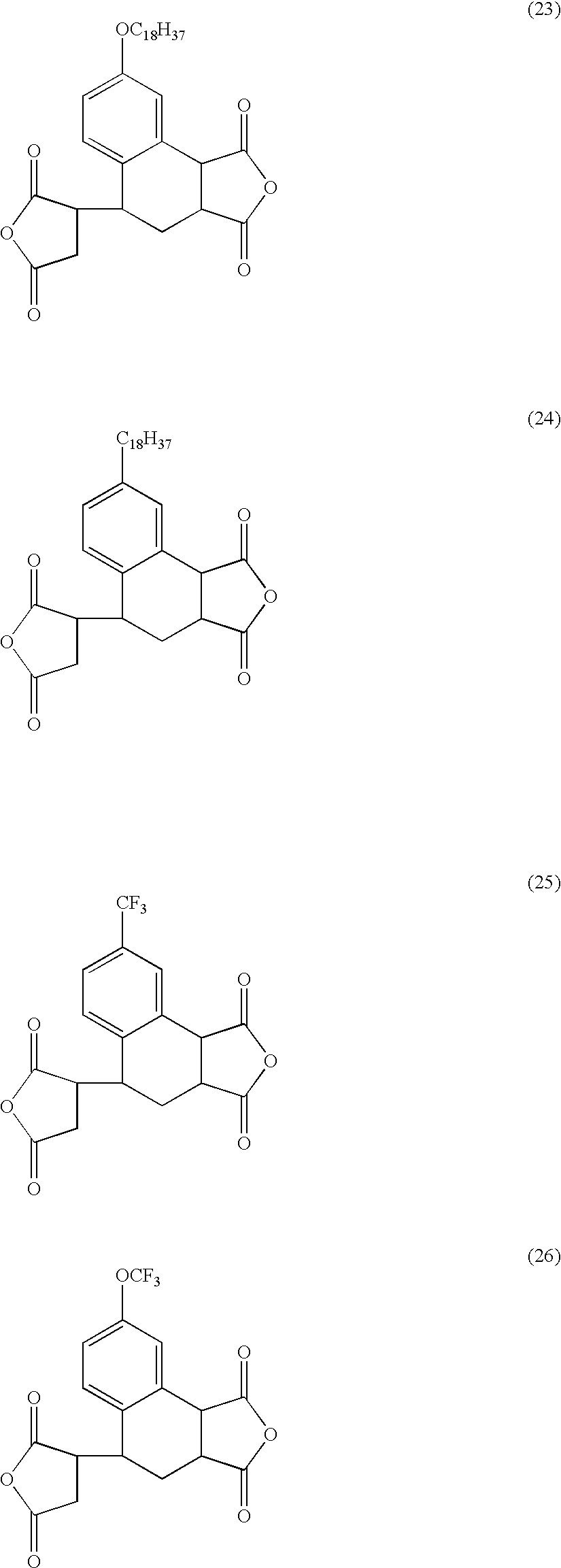Liquid crystal aligning agent and liquid crystal display element
a technology of liquid crystal display element and aligning agent, which is applied in the direction of static indicating device, instruments, transportation and packaging, etc., can solve the problems of display failure, restricted substrate size, and unsatisfactory liquid crystal aligning uniformity
- Summary
- Abstract
- Description
- Claims
- Application Information
AI Technical Summary
Benefits of technology
Problems solved by technology
Method used
Image
Examples
synthesis example 1
[0124] 0.04 mol (17.1 g) of 4-(6-(4-chalconyloxy)hexanoxy)styrene, 0.01 mol (3.45 g) of p-cetyloxystyrene, 0.05 mol (24.8 g) of 4-(6-(4-chalconyloxy)hexanoxy)phenylmaleimide and 3.0 g of azobisisobutyronitrile were dissolved in 500 ml of dimethylacetamide and reacted at 80.degree. C. in a nitrogen atmosphere for 10 hours. The obtained viscous reaction mixture was poured into methanol to precipitate a polymer which was then dried to produce 44.5 g of poly(styrene-phenylmaleimide) copolymer (to be referred to as "polymer 1" hereinafter).
synthesis example 2
[0125] 0.1 mol(42.8 g) of 4-(6-(4-chalconyloxy)hexanoxy)styrene, 0.01 mol (1.72 g) of p-trifluoromethylstyrene and 3.0 g of azobisisobutyronitrile were dissolved in 500 ml of dimethylacetamide and reacted at 80.degree. C. in a nitrogen atmosphere for 10 hours. The obtained viscous reaction mixture was poured into methanol to precipitate a polymer which was then dried to produce 37.8 g of a polystyrene copolymer (to be referred to as "polymer 2" hereinafter).
synthesis example 3
[0126] Polymerization of Polyamic Acid
[0127] 0.1 mol (22.4 g) of 2,3,5-tricarboxycyclopentylacetic dianhydride, 0.05 mol (21.5 g) of 1-(6-(4-chalconyloxy)hexyloxy)-2,4-diaminobenzene and 0.05 mol (17.4 g) of 1-cetyloxy-2,4-diaminobenzene were dissolved in 300 g of N-methyl-2-pyrrolidone and reacted at 60.degree. C. for 6 hours. Thereafter, the reaction mixture was poured into an excessive amount of methanol to precipitate a reaction product. The precipitate was washed with methanol and dried at 40.degree. C. under reduced pressure for 15 hours to produce 60.7 g of polyamic acid (to be referred to as "polymer 3a" hereinafter).
[0128] Imidization Reaction
[0129] 380 g of N-methyl-2-pyrrolidone, 16 g of pyridine and 20.5 g of acetic anhydride were added to 60.7 g of the obtained polymer 3a to carry out imidization at 120.degree. C. for 4 hours. The reaction mixture was then poured into an excessive amount of methanol to precipitate a reaction product. The precipitate was washed with meth...
PUM
| Property | Measurement | Unit |
|---|---|---|
| temperature | aaaaa | aaaaa |
| temperature | aaaaa | aaaaa |
| reaction temperature | aaaaa | aaaaa |
Abstract
Description
Claims
Application Information
 Login to View More
Login to View More - R&D
- Intellectual Property
- Life Sciences
- Materials
- Tech Scout
- Unparalleled Data Quality
- Higher Quality Content
- 60% Fewer Hallucinations
Browse by: Latest US Patents, China's latest patents, Technical Efficacy Thesaurus, Application Domain, Technology Topic, Popular Technical Reports.
© 2025 PatSnap. All rights reserved.Legal|Privacy policy|Modern Slavery Act Transparency Statement|Sitemap|About US| Contact US: help@patsnap.com



